Question
-------------------------------------------
The text above is a follow-up to ...
-----Question-----
Hi. I'm actually talking to another expert right now but I'm talking to you too hoping someone will get back to me quickly. My betta is in a 2 1/2 gallon talk with a corydora and a pleco. I now know that is too many fish in that tank. Thanks alot PetSmart. Anyway, last week my betta developed two red circles on his tail. Part of his red tail/ just with circles on the end. I know. Sounds strange. So, these two circles seperate from the rest of the tail from time to time and kinda stand straight up in the air. Go figure. Any idea what that is? Anyway, last night he developed a red (blood-red?) spot inside of one of his gills but visible from the outside. And now, this morning, he has a swollen area under his gills. What is going on? I have no medication and can't get any until tongiht. I do have aquarium salt but dont' use it becasue it might my catfish sick. Should I isolate him into a small jar and if so, do I use aquarium salt? will that help anything?????? He is eating and hungry. He jsut doesn't look good. Please get back to me as soon as possible. I'll do something about the fish and tank size later. right now I need to save my betta
-----Answer-----
Hi Marie,
I haven't read the second part of your question, but what I can tell you from how this reads is that something is amiss with the water quality. It's not surprising, given the large amount of waste the pleco produces, although I assume right now he is fairly small. What you should do, and this is always the case when any symptoms present themselves, is test your water. If you don't have a test kit, Petsmart or another local fish store will test your water for free, but you must ask them for specific readings.
0 ppm of ammonia and nitrite are a must. A must! A healthy, cycled tank never registers either of these toxic levels, but they appear when wastes build up the way they certainly would with the amount of fish you have in the tank - not to make you feel guilty, I do understand. I have gone through my share of plecos, rehoming both to friends' larger tanks and eventually outdoor ponds, when they outgrew a 75 gallon fish tank!! Granted, it took a few years, but it just goes to show you how big these fellas get...
Right off the bat, a 50% water change would serve you well. Unless you have a perfectly clean, water-tight container such as a Rubbermaid, of several quarts, I would not transfer your betta. In a small jar, wastes build up even quicker. Do a water change, and ALWAYS use dechlorinator. Prime is what I recommend you use, for the ease of dosing (3 drops per gallon, get the small size since it has a dropper bottle) and also because it is capable of neutralizing ammonia and nitrite in an emergency. Do get yourself some test kits. It's well worth the investment. Ammonia, nitrite, and nitrate are the most important levels to check. Nitrate is much less toxic to fish than either nitrite or ammonia, but these levels, too, ought to stay below 20 ppm.
This all ties in to the nitrogen cycle. You don't need to a whole know a lot about it, just that beneficial bacteria on your sufaces (gravel and filter media being the two main ones) colonize and serve to convert ammonia (raw waste, such as excrement and uneaten food) into nitrite, and nitrite into nitrate. That's what the bio-wheels on filters are for, and all the stuff labeled biological media you see for sale at the pet store. It is material designed to encourage the growth of beneficial bacteria.
If you have a fresh filter cartridge, I would replace it, but the water change is going to be the most important. Change at least 50% (but never more than 80% at once, unless there is an emergency such as an overdose of medication) of the water every day to keep waste levels down. Two water changes of 50%, say, once in the morning and once in the evening, would do no harm and serve you well here.
Check out this site: http://freshaquarium.about.com
As well as this one: http://www.bettatalk.com
As they are both beginner-friendly sites that will tell you much about caring for your new pets.
Good luck, and now I'm reading your next question...
Nicole
Okay, I just found a good description of my betta's illness on another website. It is a fungal infection. I am going to isolate him tonight in a quart jar. Don't know how much aquarium salt to add to his water. Will do full water change tomorrow. How is this fungal infection affecting my corydora catfish and my pleco???? How do I avoid this infection occurring again? I added aquarium salt once and it almost killed my catfish. I added exactly according to package instructions but it still hurt my catfish. I already lost one catfish. I don't want to lose another. Please advise. Thank you. Thank you. Thank you.
AnswerHi Marie, my computer is just creeping along this morning (sigh, dial-up) so I'm going to just reply to this one message. I know what you mean about the aquarium salt. I really dislike the packaging on aquarium salt. First of all, 1 teaspoon per 5 gallons is really too much salt to keep in your tank at a "maintenance level" the way they suggest. Second of all, the salt should really be dissolved in warm water until no grains are visible. This is pretty important, in my opinion, because bottom feeding fish like catfish scour their barbels all throughout the bottom, and contact with the salt grains will feel...well, a lot like it would feel to us if we got freezerburn on our tongue! Salt is irritating to catfish at the concentration they recommend (although that may not necessarily be what killed your catfish...) That's why for betta tanks I recommend 1 teaspoon per 10 gallons at a maintenance level.
Marie, I know you mean well and have nothing but the best intentions for your fish. I really must say that unless you get another tank ASAP, it's going to be very difficult to keep it stable and impossible to keep its inhabitants thriving. The sized tank that you have is really only suitable for a betta. The cory likes to shoal, it's one of the most social of aquarium animals. They feel nervous and they don't eat well when they're by themselves. I have tried keeping a single cory too, and they just don't thrive.
Your betta would be more disease resistant if you could keep a maintenance level of salt in your fish tank (1 tsp per 10 gallons), but your cory won't appreciate this and neither will your pleco. Your pleco has an enormous mature size, but it will really only take him a few months to reach three inches. I know you are aware of this, but what I want to stress is that whatever you do to medicate, more problems will crop up because it is just not a sustainable set up.
Ok, now that I have said my piece on that, take a look at this website which will give you all the information you need on treating bettas in jars, even how to sanitize them:
http://www.bettatalk.com/betta_diseases.htm
I personally like Methylene blue baths, because they are extremely safe and mild, but when dealing with a betta I believe you should follow the advice listed on the website. The author of the website is the founder of the L.A. Betta Society. She knows her stuff! If your betta developed the fungus while he was in isolation, I would not treat the main tank. Fungal infections are secondary infections, they occur because the fish is already weakened or diseased. If your cories and pleco seem healthy and are eating, I would just leave them alone for now. Keep the betta in isolation (I would prefer you use a jar twice this size, 2 quarts = 1/2 gallon) and follow the course of the medication. The instructions on the website are a little vague, but as she says, you have to eyeball the number of grains to measure the dose (15-20 in your case) and observe the color of the water. I would prepare this ahead of time in another container of the same size and then transfer the betta. She recommends adding 1 teaspoon per 2 1/2 gallons of salt to the water, for you that would amount to about an 1/8 of a teaspoon. Dissolve it in warm water first.
I am really sorry that you're going through this. You must get a heater for your betta to stay healthy, and you know what I have to say about your other fish. Everyone could live happily in a 10 gallon tank for a while - you could also add another cory. I know that so many people seem to keep bettas so effortlessly, seldom performing water changes, giving them a few pellets a day in a bowl full of marbles. I can't really say why for some people this "works" but I *can* guarantee you that every betta prefers a warm, stable temperature and clean water. Beneficial bacteria is the basis for biological filtration a fish tank, and marbles are not hospitable to them. Gravel is the way to go - your cory would love to have his nose in some sand or gravel.
All I can say is that I hope, since you appear to have an interest in other fish besides bettas, that you will find a happy medium for everyone. Good luck, Marie, I know you are doing your best. - Nicole

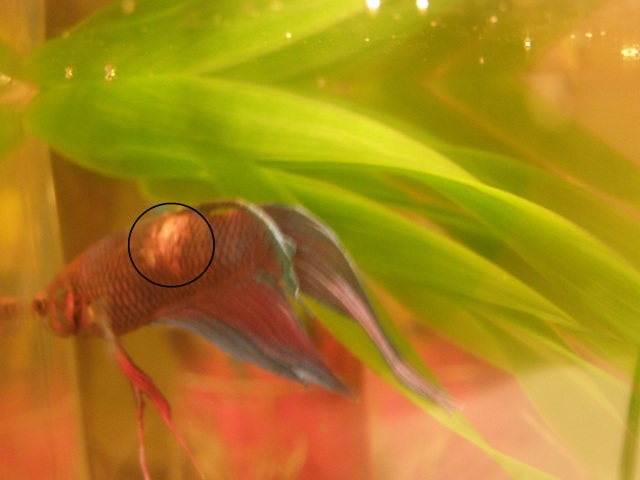 Sick bettas
QuestionPico
QUESTION: Hi Jaymie,
My roommate
Sick bettas
QuestionPico
QUESTION: Hi Jaymie,
My roommate
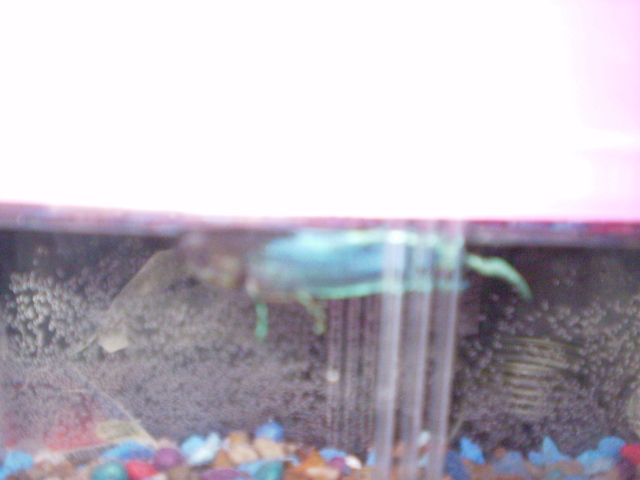 clamped fins,
QuestionQUESTION: I have a Betta that died recently. I
clamped fins,
QuestionQUESTION: I have a Betta that died recently. I
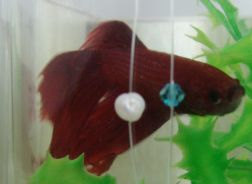 Betta Fish Dorsal Fin is disappearing
QuestionQUESTION: What could be wrong with my bettas do
Betta Fish Dorsal Fin is disappearing
QuestionQUESTION: What could be wrong with my bettas do
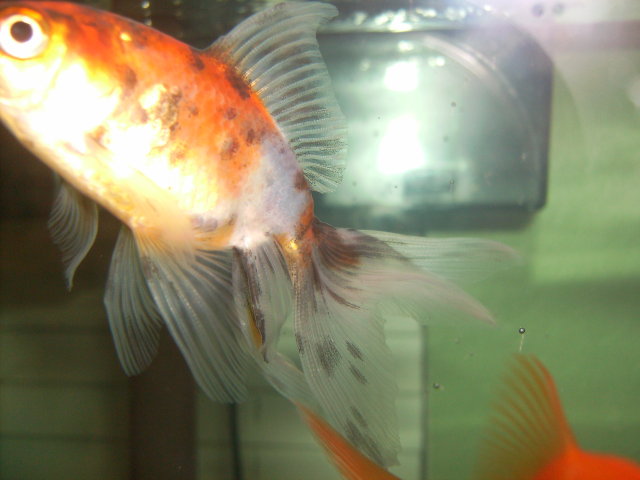 My fantail goldfish might have fungus
Questionthe sick fantail
QUESTION: Hello Jaymie,
My fantail goldfish might have fungus
Questionthe sick fantail
QUESTION: Hello Jaymie,
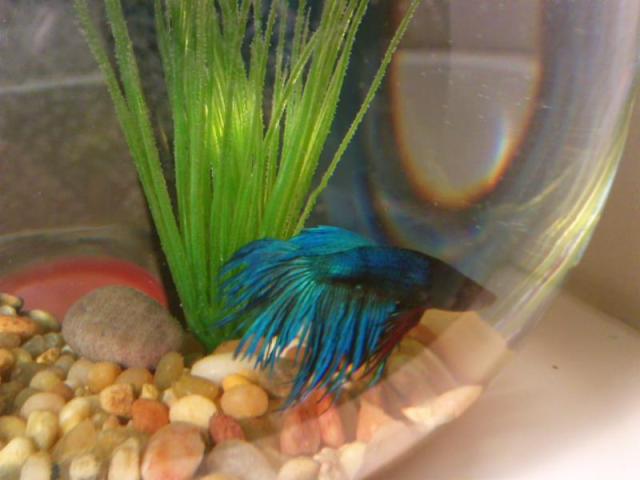 new betta fish with black dust spots
Question
ferdie
just brought home a new betta an
new betta fish with black dust spots
Question
ferdie
just brought home a new betta an